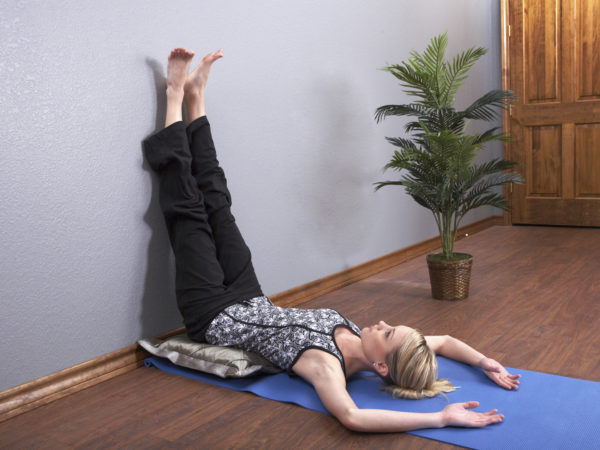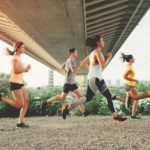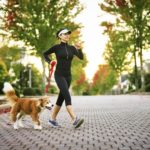Legs Up The Wall Pose

“Performing the Legs Up the Wall Pose provides a great stretch for the legs and hips, and is an excellent way to relieve stress quickly.” – Andrew Weil, M.D.
Description & History
The Legs Up the Wall Pose is an inversion pose in which you lie on the floor next to a wall and place your legs together vertically against the wall. The Sanskrit name, Viparita Karani, comes from viparita meaning reversed or inverted and karani meaning action. The pose is a restorative and relaxing pose as it inverts the typical actions that happen in our bodies as we sit and stand. It provides stress and anxiety relief as well as reducing menstrual symptoms and back pain. It is also good for leg swelling or varicose veins. The pose is simple and can be performed for extended periods of time.
How to Perform Legs Up The Wall Pose
- Begin by sitting on the floor with a wall next to your side. Your legs should be stretched out straight in front of you. Exhale and gently lie down on your back, engage your core and hip muscles to bring your legs up into the air with the bottoms of your feet pointing to the ceiling.
- Pivot your body so the backs of your legs are now touching the wall. Bring your sitting bones flush to the ground and as close to the wall as possible so your torso and legs create a 90-degree angle.
- Relax your neck and place your hands on your belly or to your sides with palms facing up. Focus on your breathing and with each breath release any stress or anxiety, starting from your feet and down through your body.
- Stay in the Legs Up the Wall Pose for five to 20 minutes. To come out of the pose, gently press the bottoms of your feet into the wall and roll to one side, making sure you support your legs until they reach the ground. Stay on the ground for a few seconds until sitting up so as to avoid lightheadedness.
- The Legs Up the Wall Pose is often a final pose in a yoga sequence and can be used in lieu of the Corpse Pose.
Potential Health Benefits
- Provides anxiety and stress relief
- Therapeutic relief for, headaches, arthritis, high blood pressure, low blood pressure
- Relieves menstrual and menopause symptoms
- Stretches hip and leg muscles including hamstrings and calves
- Relieves swelling, cramping and fatigue in legs and feet
- Relieves lower back pain
Researchers used an eight-week yoga study to see the effects of yoga on fibromyalgia, a chronic condition characterized by pain, stiffness, fatigue, and sleep disturbance. The yoga poses performed by the participants were chosen based on simplicity, one of which was the Legs Up the Wall Pose. The preliminary study of 11 participants found a significant improvement in overall health and a decrease in anxiety and stiffness. Results from the study were published in the International Journal of Yoga Therapy and suggest using yoga, including the Legs Up the Wall Pose, can provide relief for those experiencing fibromyalgia and may possibly relieve other health issues such as anxiety and stress.
Modifications & Variations
Performing the Legs Up the Wall Pose can strain your lower back and hips. You can place a pillow or a rolled-up yoga mat or towel under your lower back to relieve excess strain. You can also place a pillow or mat for support under your head. A strap can be used just around your thighs and above the knees to help hold legs in place and take pressure off the low back and pelvis.
If you are a beginner, focus on using your breath to help “ground” your body as well as relieve excess stress. On each inhale, imagine your breath is moving through your torso and pressing your thighs closer to the wall. On each exhale, imagine your thighs connected to the wall as your let your torso release any tension into the floor.
Advanced practitioners can do two modified versions of the pose. One is to place a sandbag on the soles of your feet to aid in stretching and balance. To place the sandbag on the soles of your feet after you are in the pose, bend your knees slightly and bring your heels down along the wall. Place the sandbag on your soles and press it toward the ceiling through your legs and feet until the backs of your thighs are on the wall.
A second advanced variation is to let your feet fall outward so your legs make a “V” shape. This variation provides a stretch to the inner thighs and groin muscles of the legs.
Precautions
Be careful when lifting your legs to the upright position if you have lower back or hip pain. One way to relieve excess strain on the lower back is to use a rolled-up yoga mat, towel or pillow.
Like any inversion, people with glaucoma should avoid this pose. In some yoga practices, doing this inversion while menstruating is not advised. Do not do this if you have a hernia of any kind. Also, if you have high or low blood pressure, be careful when performing this pose for extended periods of time or avoid it altogether. Lifting your legs higher than your heart can increase blood pressure and lead to heart and other health problems. The same warning is also suggested after completion of the pose when you transition from lying to the standing position. Standing suddenly can cause blood pressure fluctuations which can lead to serious injury.
Related Poses
- Bridge Pose (Setu Bandha Sarvangasana)
- Standing Forward Bend Pose (Uttanasana)
- Hero Pose (Virasana)
- Corpse Pose (Savasana)
Reviewed by: James Nicolai, M.D., on August 20th, 2013.
Sources
Hennard, Janet. “A protocol and pilot study for managing fibromyalgia with yoga and meditation.” International journal of yoga therapy 21, no. 1 (2011): 109-121.









